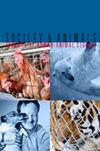动物“Ş”我们:科学和环境教育中的同构
IF 1
4区 农林科学
Q4 SOCIOLOGY
引用次数: 0
摘要
我们认为,自我形态主义是儿童在自然口译员的调解下进行的种间接触中不可阻挡的话语元素。我们通过研究加拿大一位公共环境教育家和葡萄牙一个海洋公园的海豚训练师的话语来做到这一点,同时调解这些教学经验。我们的分析工作有助于扩大对人类与非人类互动如何在科学和环境教育中创造机会的理解,以打破人类优越从而与其他动物隔绝的观念。本文章由计算机程序翻译,如有差异,请以英文原文为准。
Animals “Я” Us: Egomorphism in/for Science and Environmental Education
We argue for the notion of egomorphism as an inexorable discursive element in/for children’s interspecies encounters mediated by nature interpreters. We do so by examining the discourses of a public environmental educator in Canada and a dolphin trainer in a marine park in Portugal while mediating such pedagogical experiences. Our analytical work contributes to expanding the understanding of how human–nonhuman interactions can create opportunities in science and environmental education to disrupt the notion that humans are superior and therefore removed from other animals.
求助全文
通过发布文献求助,成功后即可免费获取论文全文。
去求助
来源期刊

Society & Animals
社会科学-兽医学
CiteScore
1.40
自引率
12.50%
发文量
46
审稿时长
>12 weeks
期刊介绍:
Society & Animals publishes studies that describe and analyze our experiences of non-human animals from the perspective of various disciplines within both the Social Sciences (e.g., psychology, sociology, anthropology, political science) and the Humanities (e.g., history, literary criticism).
The journal specifically deals with subjects such as human-animal interactions in various settings (animal cruelty, the therapeutic uses of animals), the applied uses of animals (research, education, medicine and agriculture), the use of animals in popular culture (e.g. dog-fighting, circus, animal companion, animal research), attitudes toward animals as affected by different socializing agencies and strategies, representations of animals in literature, the history of the domestication of animals, the politics of animal welfare, and the constitution of the animal rights movement.
 求助内容:
求助内容: 应助结果提醒方式:
应助结果提醒方式:


